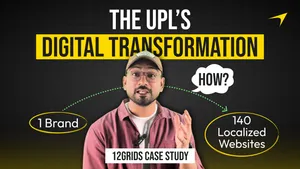The Ultimate Guide To Content Distribution Strategy In 2024
5 mins | 01 Feb 2024

Table Of Contents
2. What Is The Importance Of Content Distribution Strategy?
3. Few reasons why content strategy is so vital for businesses
4. Types Of Content Distribution Channels
5. How To Create An Effective Content Distribution Strategy For Your Business?
Introduction
What if you are creating content after content, but it is all going in vain and driving zero to fewer results? And what might be the reason behind this? Have you ever thought of this? Well, you might be very good at creating engaging and helpful content for your target audience, but if it doesn't reach them or goes unseen, then what's the worth of creating content after all? Here comes the role of “content distribution strategy! But what is a content distribution strategy, and how does it work?
Content distribution can be defined as the method of publishing content, sharing it, and then promoting it on different types of platforms. When you are curating a content plan for your business, it's crucial to have a content distribution plan in the right place to make sure your content is visible or reaches your target audience. In today's competitive world, it might be a little overwhelming for brands to stay visible to their audience now and then, and that's why the content distribution strategy is a vital concern for content creators as well as content marketers.
Content distribution supports your content to be visible to your target audience so that they can engage with it and even share it with their friends or colleagues. It might be a little overwhelming and expensive as well to build content for social media, from the time invested to many other costs. However, the investment will not be worth it if your target audience is not able to see or notice content online or if they are not even aware of your content! An effective content distribution strategy allows your business to circulate the message, information or any educational data you want to share with your audience at the right time, in the right place, and in front of the right people.
What Is The Importance Of Having The Right Content Marketing Distribution Strategy?
A content distribution strategy is highly crucial for the right implementation and the success of content marketing campaigns driven by any business. When it comes to creating content that is of high quality, educational, informative, and engaging too, it becomes important to make sure that your content becomes visible to the target audience. If there's no content distribution strategy, then your content might go unseen and will not provide fruitful results to your business.
A content distribution strategy helps fill up the gap between your content & target audience; it makes them aware of your business, creating meaningful content. You need to make sure that your content is exposed to the right people via the right mediums. Businesses must pay attention to building a content marketing distribution strategy to achieve their desired goals through creating content and disseminating it at the perfect time & platform.
Let's have a look at a few reasons why content strategy is so vital for businesses:
a) Reaches Your Target Audience: Online platforms are fully loaded with content, and to make sure that your content doesn't go unnoticed, might be a difficult task! However, a content distribution strategy helps you to target specific demographics as well as interests, which assures that your content gets seen by your target audience at the right time.
b) Creates Brand Awareness: Distributing content regularly helps to create brand awareness and also establishes your brand as a thought leader in your respective field.
c) Increases Visibility: An effectively crafted and organized content distribution strategy for content marketing is equipped with the potential to boost the online visibility of your content. Using several platforms enables you to extend your reach to a wider audience, which ultimately leads to heightened brand awareness.
d) Build Strong Relationships: A robust content marketing distribution strategy helps you to build long-lasting relationships. By creating and sharing meaningful and relevant content, you will be able to position your brand as an authority in your industry, and build loyalty.
e) Boosts Leads: In the digital landscape, content marketing has been a proven approach for boosting the lead generation process. By implementing an effective content distribution strategy, you will be able to connect with potential clients and encourage them to engage in specific actions, such as signing up for a newsletter or purchasing a product or service.
f) Enhances SEO: By publishing your content across various online channels, the number of backlinks to the website can be increased, which can help you improve the search engine rankings and drive more traffic.
g) Increases Return On Investment (ROI): Implementing a content distribution plan for your content marketing campaign is essential in making sure that your content is noticed by your target audience, eventually leading to a higher return on investment. By investing your efforts into demographics & preferences, you will be assured that your content reaches and engages with your audience.
Altogether, a well-crafted content distribution strategy will assist you in accomplishing your content marketing goals & objectives and increase your online visibility.
What Are The Three Main Types Of Content Distribution? Explained In Detail
A) Owned media
Owned media refers to the distribution channels over which a brand has significant control, and this includes platforms like your website. The term also involves most social media platforms as the brand creates and manages the accounts, even if the content is viewed on platforms such as Instagram, Twitter, or Linkedin.
The real strength of owned media lies in its ability to develop deeper connections with both existing and potential clients cost-effectively. It also offers an efficient means to engage with specific audiences, contributing to its positive impact. Nevertheless, the scalability of this type of content distribution is generally slow, and there is no guarantee that it will evolve into a prominent one within your overall content distribution strategy.
2) Earned Media
When your potential clients or existing customers serve as the primary promoters, your business engages in earned media. To put it more straightforwardly, your customers spontaneously share information about your content on different social media platforms, which actively contributes to the development of your brand recognition. This encompasses scenarios where your content goes viral, generates quite a buzz, or spreads through general word of mouth. Earned media can originate from sources such as dedicated, long-term customers or through paid media, significantly boosting your social media presence at suitable times.
In today's world, personal recommendations tend to be more trusted by many individuals than online content, making earned media a highly credible means of distributing information. In many instances, it plays a crucial role in transforming interest into actual sales. Unfortunately, brands lack direct control over earned media; they can only create conditions that can promote positive word-of-mouth. Due to this lack of control, measuring earned media comes across as a challenging task. Additionally, earned media is not always positive, as unhappy or frustrated customers and website visitors may publicly voice their complaints about a brand.
3) Paid Media
When it comes to using paid media, it typically involves the brand investing in its channels, such as display ads, influencer marketing, paid search results, sponsorships, etc. These expenditures can catalyze driving new traffic to the owned media platforms of the brand. Content distribution channels that have been gradually gaining subscribers might experience a surge as fresh eyes have discovered the content created by the brand.
Brands who opt for paid content distribution channels have significant control over their expenditures, especially when it comes to paid social media ads. Paid media has the potential to expand rapidly, providing immediate feedback in many cases. However, it faces challenges such as declining response rates due to the growing online crowd and competitiveness of the internet. Customers may perceive paid media as lacking credibility, which might demand extra effort from the brand to establish trust and loyalty.
How To Create An Effective Content Distribution Strategy?
Here are the steps you must follow to develop an effective content distribution plan for your brand:
1) Understand Your Target Audience — The first step towards creating a content distribution strategy is to learn about your target audience to figure out what type of content they prefer or are interested in! It would help if you focused on gathering data such as their location, age, preferences, etc., by looking at the demographic information on the website visitors, email subscribers, and social media followers. Moreover, it would be best if you consider questioning your target audience about what they are in search of and how your content marketing & distribution method can be improved to achieve further business motives. Develop a buyer persona to sample the ideal customer and their preferences.
2) Conduct An Audit — The content that has been published earlier must be reviewed to understand the results it has garnered for your brand and whether your content & its distribution strategy need to be improved. You can determine if your content aligns perfectly with your ideal customer. When you are checking on your content, you may come across different topics that you have already covered, and that's how you can get an idea to explore more. However, you need to find out the content gaps so that you can create content in those areas.
3) Study Your Content Types & Distributing Opportunities — When it comes to selecting the right content distribution platform for your content, do not forget the preferences of your audience. Figure out what are the channels that your audience likes to spend most of their time on! Once you have chosen the platform to distribute the content you have developed, you can now start focusing on the type of content to develop based on your audience’s preferences.
4) Set Up Content Distribution Goals & KPIs — Establish targets for KPIs and metrics so that you will be able to evaluate the results after your content distribution process. Begin with developing “SMART” objectives; they are Specific, Measurable, Attainable, Relevant, & Time-Bound. Having a well-defined SMART goal serves as a constant reminder of the purpose of your content and ensures its delivery to the intended audience.
5) Build An Editorial Calendar — To coordinate your content marketing efforts with content distribution, consider creating an editorial content calendar. This helps in facilitating team cohesion during project execution by describing tasks that have to be completed or updated. Within the editorial calendar, incorporate essential details such as keywords, format, marketing goals, etc. In addition, you also need to specify the intended platform for distribution. Making an editorial calendar allows for strategic content delivery.
6) Create Engaging Content — Once the operational details have been sorted, start developing your content. Explore the usage of different online platforms or tools to assist in creating your promotional materials. Make sure that the tone and message of your content are aligned with your brand identity. Additionally, think about concentrating on a particular domain or specialization to connect with a specific audience. As an example, a business specializing in milk products might opt to initiate a campaign showcasing its lactose-free milk products to cater to individuals with lactose intolerance.
7) Start Distributing Your Content — In accordance with your calendar and strategy for distributing content, make sure that the publication of your content happens on the chosen platform. When sharing on your selected channels, carefully consider the optimal timing to maximize engagement. For instance, if your audience is generally active on social media platforms like Instagram or LinkedIn during the evenings, contemplate scheduling a social media advertisement for nighttime posting.
8) Analyze The Content Distribution Strategy — After publishing your content across different channels, you must assess the performance of your content distribution strategy by analyzing the outcomes. Do not skip reviewing the KPIs or Key Performance Indicators to specify if the metrics signify a successful result. For instance, if your objective was to increase engagement on your website, then you should analyze factors such as the average duration visitors spend on your page and the bounce rate to assess whether more web visitors are staying on your website. You must consistently monitor your KPIs to track their growth over time and identify necessary adjustments.
In Conclusion
Developing an effective content distribution strategy is necessary for reaching and engaging your target audience in today's digital landscape. By understanding your audience, selecting the right channels, and optimizing your content for each platform, you can now maximize the impact of your content and enhance its visibility.
Consistently analyze performance metrics, adapt according to emerging trends, and foster a consistent as well as authentic brand voice to ensure long-term success. A well-crafted content distribution strategy not only helps to increase the reach of your content but also establishes a meaningful relationship with your audience, driving sustained growth and success for your brand.
Key Takeaways
- Tailor content distribution channels to your target audience for maximum impact.
- Prioritise quality over quantity to ensure that each piece of content adds value to the audience.
- Utilize a mix of platforms, such as social media, email, and websites, to reach diverse audiences.
- Consistency is key – establish a regular content distribution schedule to maintain engagement.
- Utilise analytics to refine and optimize content distribution, ensuring maximum visibility and relevancy.
- Capitalize on the continued influence of different social media platforms by crafting tailored content for each channel to boost engagement.
Author

Share
Share
Related

Why Understanding Local Users Was the Secret Behind UPL’s Global Digital Success
3 mins : 26 Nov 2025

How Content Marketing Transformed Goldstab Organics’ Online Presence?
5 mins : 11 Nov 2025

Building Trust: How Content And Ratings Turn Visitors Into Buyers
5 mins : 18 Sept 2025
Other Articles

Meeting Customers Where They Are: WhatsApp As A Sales Channel
5 mins : 17 Sept 2025

21 Content Marketing Metrics That Every Marketer Should Track
5 mins : 30 Dec 2023

The Ultimate Guide To Winning Content Marketing Funnel For Marketers
4 mins : 04 Jan 2024
